Memory Foam Mattresses Guide: Everything you need to know
Updated 2020: There are plenty of better alternatives to memory foam out there and our guides are here to help you find and understand them. Memory foam mattresses should only be chosen if your budget is severely limited i.e. £400 or less. Spending any more than this, sometimes £1000 plus on a pure memory foam bed makes no sense to us given the alternatives available made of natural more durable materials. Most people either love or hate the sensation of a memory foam mattress. So its worth really doing your research before buying a memory foam bed online.
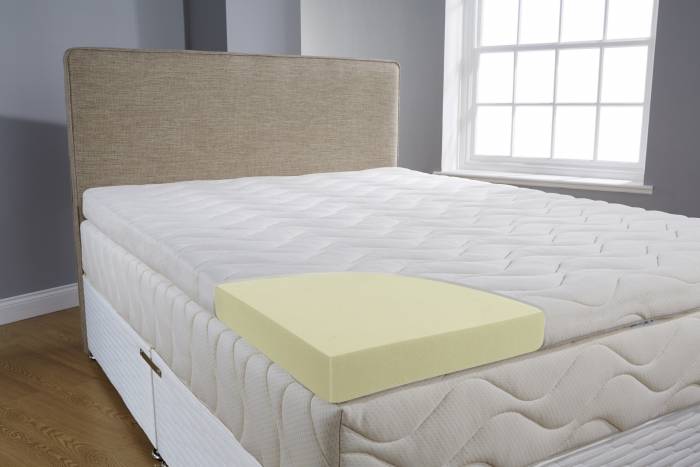
Just like buying any mattress you really do need to do your research to be able to choose the very best mattress. Here is your one-stop-shop for everything you need to know about memory foam mattresses.
Should I buy a memory foam mattress?
Memory foam mattresses have been around for nearly 30 years now. You may be tempted by them in thinking they can offer you a better night sleep. Memory foam mattresses may go by many names from Eve, Casper, Tempur, Simba and a whole other set of ‘space-age’ mattress descriptions. They all contain variants of memory foams that have been man-made such as Memory foam to synthetic latex (nothing like the real thing we’re afraid!). One of the common questions is should I buy a memory foam mattress? That depends on whether or not you fully understand what memory foam is! So let’s take a really detailed look at memory foam mattresses.
- What is memory foam?
- How is memory foam made?
- Why does memory foam get so hot?
- Is memory foam safe?
- How are memory foam mattresses made?
- Why are Memory Foam beds onesided?
- Density of Memory foam explained
- Memory foam prices explained
- What is Tempur memory foam?
- How long does it take before the smell goes on memory foam?
- How to compare memory foam mattresses?
- Top 5 memory foam facts
What is memory foam?
Many brands provide an overly scientific and confusing answer or simply baffle you in terms of marketing blurb. One fact to set straight is that memory foams only memory is to return to its original position once the person on it gets off it. It won’t remember your body shape once you get off it! It would be more accurate to call memory foam ‘heat-reactive foam’ but that doesn’t sound nearly as sexy does it?
Memory foam is a man-made foam which has a high density and viscosity compared to other foams. Memory foam has an open cell structure which allows it to change shape with heat and mould. This type of foam is typically heat sensitive, which means it reacts to heat making it softer and more pliable, so when someone lies on it, their body warmth allows the memory foam to mould to their body shape. We say typically because there are exceptions in the lower density memory foams that don’t rely on heat to mould to the person on it. We will discuss this in our hybrid foams section.
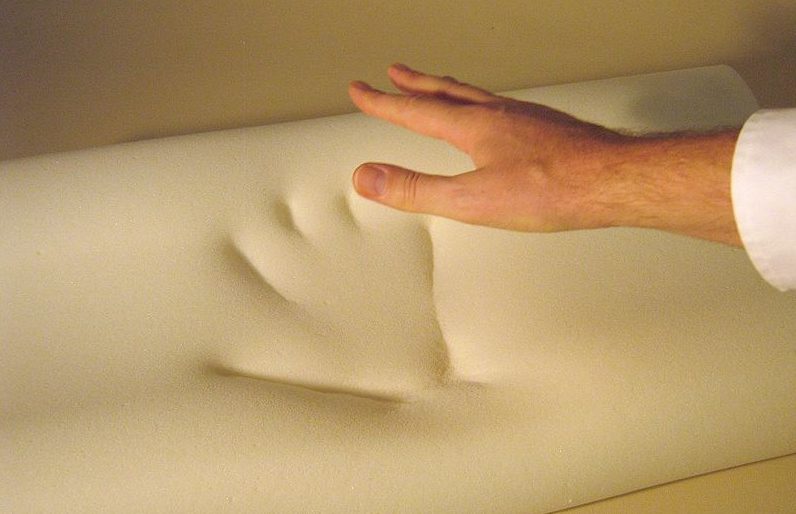
Memory foam comes in a variety of densities or firmness ratings; from 40kg which is considered a soft memory foam up to 85/90kg which is considered a firm foam. Memory foam comes in a huge variety of densities and qualities. Yet even the highest quality memory foam will still be a lower quality choice than say a traditional pocket sprung mattress or a natural latex mattress. When discussing memory foam, you must remember that
When discussing memory foam, you must remember that there is no one uniform type of ‘memory foam’ there are hundreds of types and it really is a basic / starter material in mattresses when in its reflex foam topped with memory foam layer method.
Density and hardness are quoted according to in-house test methods based on BS EN ISO 845 and BS EN ISO 2439 respectively.


How is memory foam made?
Memory foam is a chemically produced foam, not too dissimilar to other foams you may have around the house. The difference is that memory foam is viscoelastic, or reacts and softens when subjected to heat.
Memory foam comprises of a number of chemical compounds used in its manufacture. Each brand may use different suppliers from different countries. This means that memory foams won’t all share the same exact chemical compositions, each manufacturer will have their own recipe or formula. Each country also has its own chemical standards and accepted rulings of the use of them. A cheaper mattress from China may have a completely different ‘accepted’ set of chemical ingredients to one manufactured in the UK or the USA. This ingredient list is kept a close guarded secret. It is a minefield to find the quality and composition of memory foams, which begs the question ‘What secrets are they keeping?’. The fire regulations (FR) set by each country differ so imported memory foams may not meet the requirements of the UK.
That said there is a set of some 61 ingredients that are likely to be found in memory /viscoelastic Foam.

Memory foam is manufactured as a polyurethane foam using water, isocyanates (common examples toluene diisocyanate and methylene diphenyl diisocyanate) and polyols (common examples glycerine, petroleum, plant based oil derivatives) which are usually sprayed onto each other on a conveyor belt and then combined with a reactant that acts as a catalyst to create an open cell structure.
This may all sound very complicated but we simplify it as follows:
- Water and a number of chemicals are combined (isocyanates & polyols), with an agent (reactive)
- This makes them then react a certain way aerating them (giving them the open cell structure) to create a foam.
- These are either sprayed continuously onto a conveyor belt or then poured into moulds and allowed to dry.
- Once dry you have the finished product of ‘Memory Foam’.
A small change in some of the chemicals then alters the density, hardness or response rate of the foam. The majority of foams are manufactured using a slab stock manufacture process, which is the process above of making large ‘slabs’ of memory foam using the conveyor belt process rather than individual moulds which would be incredibly expensive.
The end result is a foam which reacts to heat, making it mould and conform to whatever shape and pressure that is placed upon it, usually a human! Memory foam is often described as a foam that allows you to sink slowly into it as it moulds to your body.
Interestingly people either love or hate this sensation, but fear not there are a variety of variations of these properties! The main criticism is that memory foam soon loses its memory which is a real problem for people especially given what an investment a new mattress is, hybrid foams, for example, don’t need as much heat or mould as much. Latex, on the other hand, is vastly more responsive than memory foam and outlasts memory foam significantly.
Why does memory foam get so hot?
This is one of the most frequently asked questions. Memory foam works by reacting to heat which allows the materials open cell structure to change and flex to the warm shape placed upon it. Like any foam, it will retain heat. For some people, this is not a problem they barely notice, but for other ‘hot sleepers’ they have complained that it becomes too hot. It really is a personal preference but by its very nature memory foam is heat-retentive and much warmer than any other mattress material.
Due to memory foam reacting and softening to heat it can, therefore, feel softer in the summer warmer months and firmer in the winter. This depends on the temperature of the room. This can lead to your mattress having a completely different feeling depending on the time of year and weather!

The newer hybrid range of mattresses uses more innovative types of foams that have heat dispersing properties. These Hybrid foams evenly distribute the heat through the material providing a cooler sleeping experience for the person, such as Coolblue or don’t rely on heat at all to provide their softness and comfort, Laygel is a perfect example of this. Latex is naturally breathable allowing air to circulate preventing the mattress from retaining too much heat.
There are also aeration layers, such as castellated foams, that are put into mattresses which have benefits and drawback as well. Due to the fact that castellations can change the feel and firmness of the foams, we don’t currently use or manufacture with these methods. We believe with the newer hybrid Foams and latex this is unnecessary.
What mattress should I buy if I’m a hot sleeper?
If you already know you’re a hot sleeper then a Natural fibre traditional mattress will be far more suitable than any foam model. They don’t require heat to provide their comfort and during the summer months, Natural Fibres can help wick moisture away from the body helping to keep you cool. They are also far longer lasting than synthetic foams that tend to compress quickly.
What about the new Hybrid Memory Foams?
The new Hybrid range of mattresses uses more innovative types of foams that have heat dispersing properties. These Hybrid foams evenly distribute the heat through the material providing a cooler sleeping experience for the person, such as Coolblue or don’t rely on heat at all to provide their softness and comfort, Laygel is a perfect example of this. Latex is naturally breathable allowing air to circulate preventing the mattress from retaining too much heat but will still be warmer than natural fibre. So either way, if you’re a warmer sleeper you should avoid.
There are also aeration layers, such as castellated foams, that are put into mattresses which have benefits and drawback as well. Due to the fact that castellations can change the feel and firmness of the foams we don’t currently use or manufacture with these methods. We believe with the newer Hybrid Foams and Latex this is unnecessary.
Is memory foam safe?
There are a number of sites warning of memory foam and health risks with certain chemicals used in their manufacture. With most man-made materials there are a number of synthetic materials many of which will be present in your home and as always we want to provide you with the facts to make an informed decision. It is true however that memory foam probably has the highest percentage of chemicals contained within it compared to other mattress materials. It really is a cocktail of synthetic elements used to make it both soft and slow to mould.
There are some other chemicals which are subject to debate about the safety and volatility of them being present in a mattress.
The following are frequently cited.
- Acetone
- Dimethylformamide
- Toluene
- Methylene diphenyl diisocyanate
- Methyl chloroform
Our view is that you should only buy a memory foam mattress if your budget is limited. Whilst there is a debate on whether it is fully safe or not it seems to depend entirely on the individual. People suffering from allergies or reactions to certain chemicals should think about moving to a more natural product to avoid any potential reactions to memory foam. We always advise people to undertake their own checks and tests before committing to memory foam if they are concerned about the synthetic chemical composition of memory foam mattresses.
For a further review of memory foams structure here is one example of a data sheet for the more scientific of our viewers!
| Foam Grade | Density Min KG/M3 | Density Max KG/M3 | Hardness Min (n) | Hardness Max (n) |
|---|---|---|---|---|
| Vasco 40kg | 38 | 42 | 40 | 60 |
| Vasco 60kg | 58 | 62 | 70 | 100 |
| Laygel 60kg | 57 | 63 | 100 | 150 |
| Coolblue 70kg | 65 | 70 | 70 | 100 |
| Reflex 300 | 30 | 32 | 100 | 130 |
| Reflex 300F | 30 | 32 | 130 | 160 |
How are memory foam beds made?
This is a common question that we frequently get asked about Memory Foam beds. Memory foam beds are created using layers of foams which are all adhered (with glue) to each other. It’s a bit like layering up a sandwich. All memory foam beds such as Tempur, Eve, Casper and Simba start with a reflex foam support layer or equivalent. This is equivalent to the spring unit you would see in a pocket spring mattress. It’s essential that you get the right density of this foam for your bodyweight. Too firm and it will be punishing to sleep on. Too soft and you risk waking up with backache during the night.
Layers of softer memory foam are then layered on top of this until you reach the very top layer of the mattress. This top layer is also known as the comfort layer.

As the layers progress from firmer to softer it also means that memory foam mattresses are nearly always one-sided. Meaning you can only ever use one side. If you were to flip it over you would be sleeping purely on the solid support foam. This is a major drawback with memory foam mattresses.
Why are Memory Foam Beds all No Turn?
The unfortunate drawback with all memory foam mattresses is that they are nearly always one-sided. This is sometimes sold as a ‘no turn mattress’ benefits. However, its really no benefit to you the consumer. No turn mattresses mean you can onlyu ever sleep on one side. Vastly reducing the mattress shelf life and increasing the chances of it settling and dipping. Watch our guide below on why you should really avoid one sided mattresses.
Deciding the best memory foam density
How do you decide what density is best? The density of memory foam causes the most unnecessary confusion and is the subject of much hype and leads to it being mis-sold. I always say ‘aim for the best pay the least’. The higher the density does not always mean the higher the quality. The higher the density usually means the firmer the foam, though there’s more on that here. Whilst an 85kg density foam means there’s more of the raw ingredient in the foam, if you’re only slight in weight or want a medium mattress then this would be overkill. So although you’re getting more component for your money, in terms of comfort it will fall short. Ideally, a 60-75kg density foam is sufficient for most people. If you’re wanting a really firm foam bed then latex is a better and more breathable alternative to the really dense heavy heat retentive memory foams.
A good rule of thumb is that: the higher the density the firmer it will be.
The lower the density, the softer it will be. The higher the density the longer the response (rebound) time will be. The higher the density [may] mean the more heat it retains. As a comfort layer on foam, 55-65kgm3 is the most common combination from nearly all manufacturers. Somewhat softer than an 85kgm3, but if you are getting it at a good price you won’t be regretting it. Just because an 85kg is a better quality doesn’t necessarily mean that it will suit your needs any better. A person with a light bodyweight may find it too firm for example.
What to look for in a memory foam mattress?
It’s simple really. Unless you know what to look for there is no foolproof way for a consumer to tell what the actual density is. Therefore, a salesman could tell you that the mattress contains an 85kgm3 memory foam layer when in actual fact is a standard 58 – 65. Bear in mind that memory foam can come in as low as 40kgm3 often described as super soft. I have also seen mattresses described as memory foam but contain nothing more than differing densities of standard Reflex foam. Be careful out there!
In reality, the selling price of the mattress will be the best determining factor. A 1000 pocket sprung double mattress with an acceptable 2″ basic memory foam layer (60kgm3) should not be costing you much more than £350. £400 If you are asked to pay more than this then shop around a bit more. The main question you should be asking is how deep is the memory foam layer? Just because a description states that a mattress contains memory foam could mean that the depth can be as low as 1cm practically worthless.
| Foam Grade | Foam Type | Density Min KG/M3 | Density Max KG/M3 | Hardness Min (N) | Hardness Max (N) |
|---|---|---|---|---|---|
| Vasco 40 | Vasco Memory Foam | 38 | 42 | 40 | 60 |
| Vasco 60 | Vasco Memory Foam | 58 | 72 | 70 | 100 |
| Laygel 60 | Laygel Hybrid Foam | 57 | 63 | 100 | 150 |
| Coolblue 70 | Coolblue Hybrid Foam | 65 | 70 | 70 | 100 |
| Reflex 300 | Reflex Support Foam | 30 | 32 | 100 | 130 |
| Reflex 300F | Reflex Support Foam | 30 | 32 | 130 | 160 |
The longevity of memory foam was once described as in excess of ten years. Back then, the price commanded for memory foam was in the several hundred and so it made commercial sense to advertise the product as long-lasting and so on. In my view it turns out that memory foam starts to slowly lose its recovery properties after about three years or so, and you will see on most warranties for memory foam/combi mattresses that a disclaimer is written in that ‘a permanent indent of three quarters of an inch or less will not warrant replacement’.
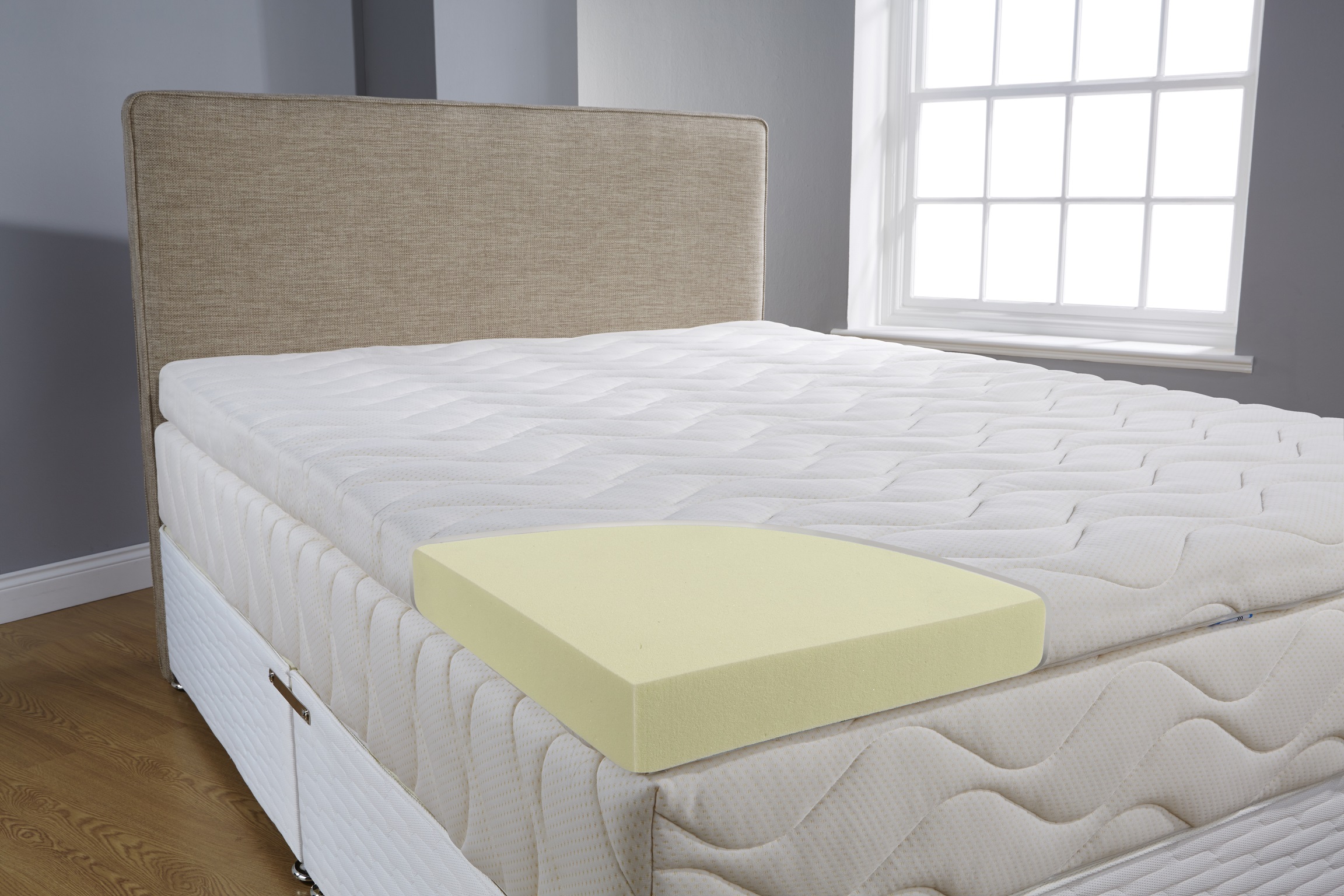
What depth of memory foam should you look for?
On a sprung mattress, the depth is usually 2″ or 5cm. This is generally regarded as the optimum depth and it is unusual to find a layer with a higher depth than this. It is also unusual to find a mattress with dual-sided memory foam although they are on the market and to me seems rather unnecessary. Always weigh up the cost implications with a double-sided memory foam mattress. Is it better to replace sooner and pay less, or keep your mattress longer and pay more?
On a memory foam/reflex foam combination mattress, the depth of memory foam should again be at least two inches. Depths less than this on a high-density foam base are deemed to be budget or economy levels. As a comfort layer on a sprung mattress, it is usually 1″ with another layer of foam or 2″ in isolation or even 2″ laminated to a 1″ layer of reflex foam. As with memory foam on foam, the combinations and detail that can be utilised are enormous.
How deep should a Memory Foam Mattress be?
Memory foam mattresses come in depths of 15cm to 30cm here in the UK. The thinner the mattress the less support and comfort you will receive from it. As a rule of thumb, you ideally want any new mattress to be at least 25cm deep to ensure it lasts longer than a couple of years. It also means that as the bed inevitably softens and settles there is still enough memory foam left to provide comfort. This is why memory foam mattresses are often criticised for sagging and dipping really quickly. Due to their incredibly high compression rates coupled with the fact you can’t turn them over.
if you sink in too much you will be sleeping in a hollow or dip that won't recover until it has cooled down
Memory foam pricing explained
Why the vast variations in price? When looking at memory foam mattresses you really do have to compare ‘like for like’. We admit this is easier said than done which you will probably soon find out.
The three most important aspects of comparison are:
- The depth of memory foam in the mattress
- The density of the memory foam.
- The price for just these two measures
How much should I spend on a memory foam mattress?
Anything more than this is only add-ons that make the mattress more suitable to you. The price differences you will see reflects all the bells and whistles that have been added onto the mattress basics. For example, it may have a high-tech moisture control fabric such as Outlast/Climasmart/Coolmax. The foam support layer may be vented/zoned/convoluted etc to channel air. The memory foam layer(s) may be layered in varying densities.
The brand of foam also dictates the price with brands such as Tempur and their Tempurpedic foam commanding a much higher price. Remembering Tempur is not technically memory foam. Foreign exports from China will be cheaper than the UK manufactured memory foams so make sure you ask when looking at models. Prices vary from a discount £99 bargain basement imported mattress to £3000 for a top of the range Tempur model.

| How much to spend on a double mattress? | What can I expect for my money? |
|---|---|
| Under £500 | Will not get you much at best a 13.5 gauge open coil/cage sprung with a thin polyester layer or a solid foam mattress. |
| £500 | Entry level spunbond springs with some form of synthetic upholstery. Usually one sided mattresses. |
| £750 | The beginnings of a basic pocket springs unit with 800 – 1000 count. No substantial amount of filling other than foams and synthetic materials. Two sided models. |
| £1000 | Should get you away from most low ranges and into the mid-range pocket spring models. |
| £1250 | Should get you a decent pocket sprung mattress with some Natural Fibre content. |
| £1500 | Should get you many manufacturers mid-range models with Natural Fibres |
| £1500-£2000 | Should get you a Hand Made primarily Natural Fibre Quality Mattress |
| £2000+ | You should expect 100% Natural Fibres and Traditional Hand Made Construction Method. |
| £5000+ | A Bespoke Hand Made Sleep System, High-end Spring Units & Featuring the Worlds Most Luxurious Natural Fibres. |
- What to expect from a £500 Mattress
- What to expect from a £750 Mattress
- What to expect from a £1000 Mattress
- What to expect from a £1250 Mattress
- What to expect from a £1500 Mattress
- What to expect from a £2000 Mattress
What’s the difference between Tempur and memory foam?
This really is the million-dollar question to answer and is quite subjective. We have a very detailed article on Tempur mattresses here.
If you start with Tempur the market leader who are charging in the region of £1500 – £3000 for the mattress alone, they are using 85kg density ‘Tempur’ foam which has a firm feel. Their foam isn’t available anywhere else and is patented. They have three main models, the Tempur Original which is the firmest, the Tempur-Cloud which is the softest and the Tempur Sensation which is a version in-between the two which is said to have more ‘bounce’.
They have undertaken the original research and development and their prices bare this cost. Tempur also has a depth measure on their model names such as 22 which indicates a 22cm deep mattress. Dreams and other authorised retailers sometimes microbrand the Tempur mattress with other suffixes or names. This can cause some confusion amongst customers as to which model is which. For example, the ‘deluxe’ tag is usually used on models over 21cm.

All memory foams are Tempurpedic but only Tempur can legally use this term due to their brand. One thing to note with Tempur and Tempurpedic foams is that they have a very similar feel to non branded memory foam. As they both work on the same principles or heat and pressure.
Why does my memory foam mattress smell?
Memory foam mattresses can have a very distinctive synthetic odour when they first arrive. This is down to the fact that the synthetic chemical foam needs to off-gas. Ie releases certain particles as it settles and acclimatises. This is often exaggerated by the fact that many of these mattresses have been factory sealed in plastic bags as soon as they are made. Meaning this process of off-gassing gets built up and then released into your home. That said all new mattresses will have a new smell to them and offgass to certain degrees. With a natural fibre mattress, you may get an earthy smell from a wool mattress.
We advise you always air your bedroom when you take delivery of a new mattress to help reduce and dilute this initial off-gassing.
How to compare memory foam mattresses?
The cheaper end of the market, typically selling £400 mattresses, may only be using 40kg density foam, at maybe 2cm depth, with a lower hardness rating which is far softer. They can offer products at this price because they are probably offering low quality cheaper Memory Foams some of which may be imported from outside the UK. You then have everything in between.
To make matters even harder to analyse few of the brands offer you the exact densities, qualities or depths of foams used so it really is difficult to assess and compare mattresses. Some will offer a few of the facts and the competitors some different select facts, very few give you all the information. It really is a memory foam minefield out there!
To be able to compare mattresses the main questions you should be asking are;
- How many layers and components does the mattress have?
- What are the depths of each of the mattress layers?
- What are the densities and associated firmness ratings for the foams?
There is also the base layer or reflex foam to consider which confusingly will have a different density rating typically 30-33kg density. This conversely is firmer than memory foam because it has a different chemical composition! Confused? Bare with us!
Memory foam typically has a density from 40kg (soft) to 85kg (firm) and there is a tolerance in the manufacturing techniques, so an 85kg foam could be anywhere between 80kg and 90kg in reality. Reflex Foam is a much denser foam so its firmness is usually measured between 30-33kg, as an 85kg piece of reflex would feel like a slab of marble!
Each brand tries to have its own unique selling point using a barrage of luxury, sumptuous and qualitative descriptions, but bear in mind what you want to know are the hard cold facts which you can then compare them by.
The only sensible way to compare memory foams is via data sheets for each of the foams you want to compare. The difficulty is manufacturers won’t usually release them
When it comes to comparing memory foam mattresses it is possible to compare two models side by side. That is if you know exactly what layers of foam are used.
Obviously retailers don’t want you to know this as it enables you to see exactly what you’re getting, or not in most cases, for your money. A good example is using the Eve mattress model which gives a breakdown of the layers contained within. However, it lacks any real meaningful detail making the breakdown pretty useless for comparison purposes. Let’s take the Eve ‘Comfort layer’ its 30 times more cool than memory foam but it doesn’t give you the density or depth for you to truly assess it. How is it cooler? What’s the hardness of the foam and likelihood it will settle?
We know that foam layers of less than 5cm are pretty pointless once they have compressed making this comfort layer a point of weakness in foam mattresses.
Whilst our Origins 1500 mattress is not a solid foam model like Eve its a good comparison for the price point of what you should expect for your money. Another point worth noting with all mem0ry foam mattresses is that they are one-sided. Meaning you can never turn them. That means that one side of the mattress gets all the wear and will inevitably compress far faster and not last as long as a two-sided mattress. This is probably why Eve only offers a Warranty (which usually only give you back a proportion of your spend if it is deemed faulty) and not a Guarantee (which offers a replace or repair option) as we do. You can read more on the difference here.

| Origins Pocket 1500 | Eve Mattress | |
|---|---|---|
| 1 | 300GSM Wool | Eve 'Comfort Layer' (No density or depth given 4cm?) |
| 2 | 750GSM Very Soft Polyester | Memory foam (No Density given or depth 5cm?) |
| 3 | 500GSM Polyester Pad | NA |
| 4 | 1 inch Foam Insulator | NA |
| 5 | 1500 Individual Spun Bond Pocket Springs (Medium tension) | 15cm Castellated Reflex Foam Base |
| Total GSM: | 1550 | NA |
| 2-Sided? | Yes | No |
| King Size Cost | £645 | £699 |

Top 5 Memory Foam Facts
1. Memory foam is also known as viscoelastic foam and reacts to heat to mould to the person lying or sitting on the Memory foam. The only Memory that Memory foam has is to return to its original position.
2. Memory foam reacts to heat and is heat retentive, some sleepers report an issue of the mattress making the sleeper feel hot.
3. There is no one standard memory foam there are hundreds of varieties with different chemicals present. Quality is key and comparisons of different foams based on feel/touch alone are difficult.
4. The density of the memory foam used will generally determine the firmness of the mattress, the higher the density usually determines the firmer the mattress. Reflex foam is the exception being much firmer at a lower density! Check out our easy explanation of density, hardness and firmness here.
5. Memory foam will over time compress just like any other foam, the trick is to ensure that the top layer is, at least, 5cm in depth to avoid this becoming troublesome. Most pure memory foam mattresses only have the top layer of memory foam and a firmer Reflex foam at their core, meaning the top layer is the most important part in basic memory foam mattresses. All our mattresses have multiple layers to remove this concern.

When memory foam is used as a comfort layer on pocket springs it is exceptionally comfortable and more importantly, far durable than a mattress with a polyester comfort layer. It does not really make a bit of difference in density as long as the mattress is comfortable. The price will/should always reflect the quality of the foam anyway. The heat properties associated with memory foam on foam combi mattresses is not as great (but is there) when used on any sprung mattress as there is plenty of natural ventilation through the springs.
However, some people really are overly sensitive to night heat if this is you then avoid any memory foam mattress. Memory foam on foam does have a much-reported reputation for being ‘too’ warm for the reason that there is no practical ventilation through the foam. It is a heat retentive mix and that can be a downside to some people. However, there are equally as many people who do not seem to notice this as a problem. For example, those of you who need an electric blanket in the midst of Summer.
Memory foam mattresses may not suit everybody but to some, it is seen as a godsend. I would also say that for those of you looking for cheap mattresses for the spare room, children etc. A memory foam mattress at the lower price spectrum will be far superior to any cage sprung mattress of a similar retail price. The memory foam industry is a massive multi-million-pound market and hence wide open for unscrupulous traders willing to part you with your money and will tell you anything in order to do so. Buying a memory foam mattress is a minefield in itself and no doubt you have found this out already.
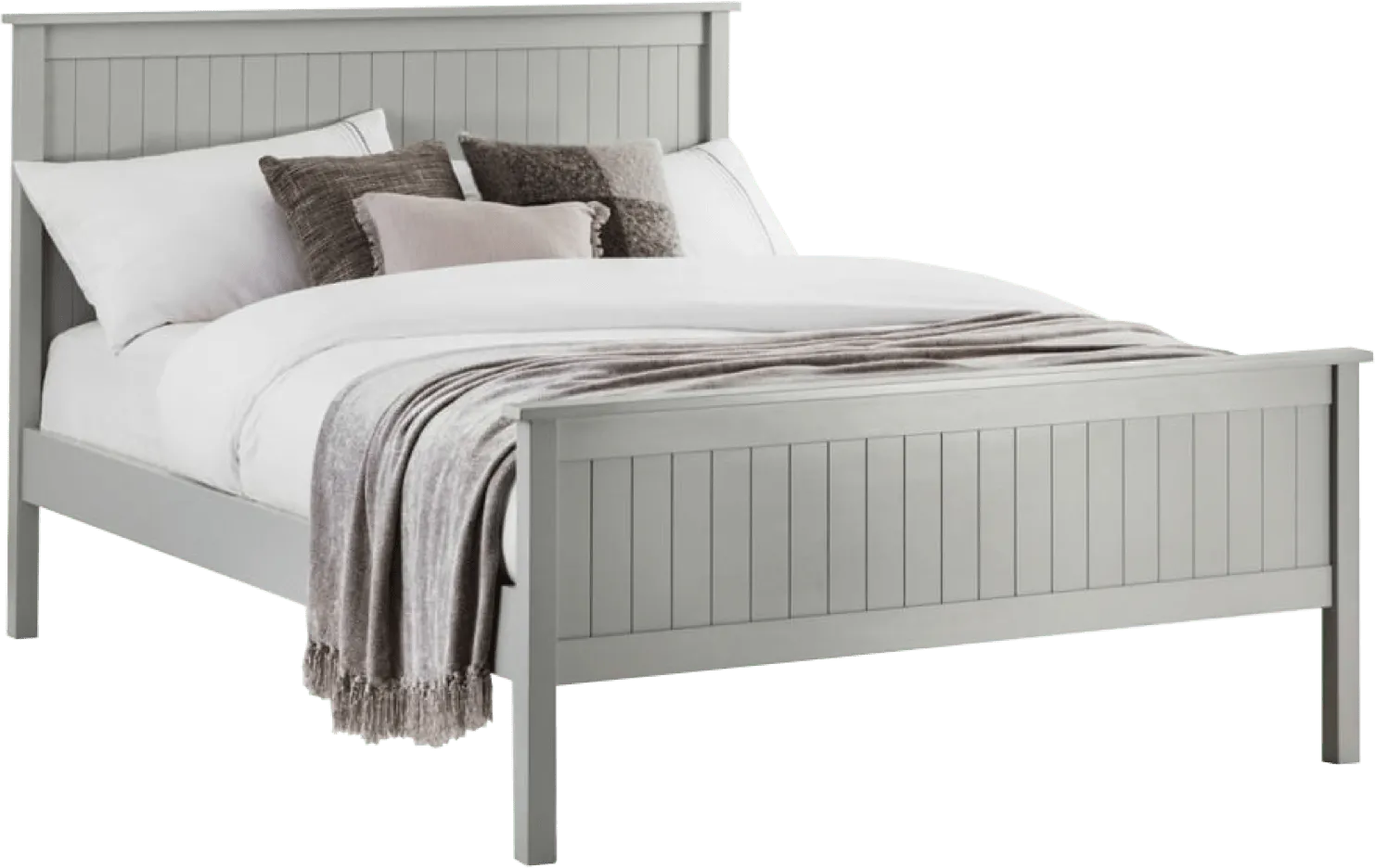
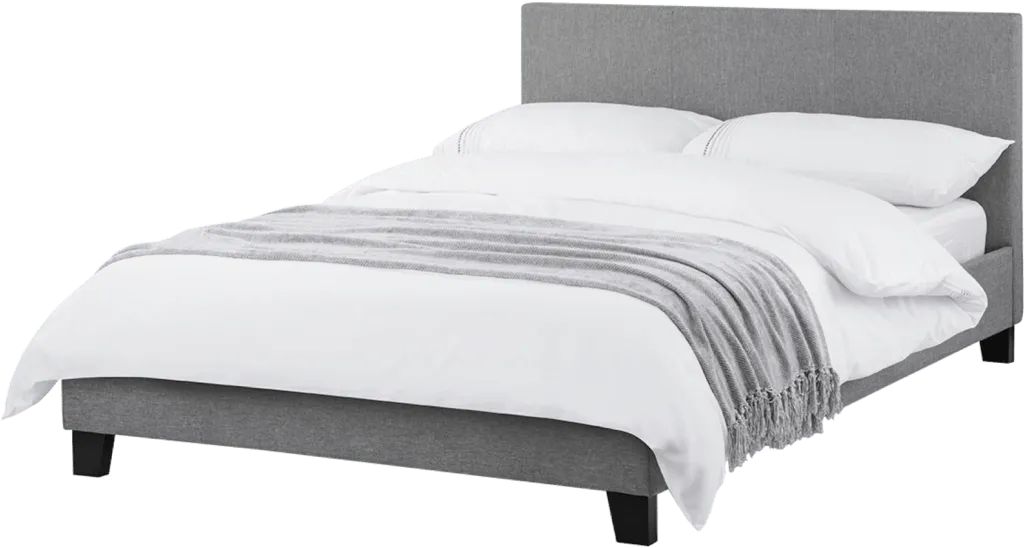
Ask us a question.
There are over 6000 questions and answers submitted by you on all questions about mattresses and bed problems. Enter a keyword such as Vi Spring, John Lewis beds, bad back or Memory Foam and see if your question has already been answered.
You can filter popular questions by the categories below. If you can’t find an answer, ask a new question below. We aim to respond to all questions within one working day.




































 Mattresses
Mattresses  Take our mattress quiz
Take our mattress quiz  Contact
Contact  About us
About us 


